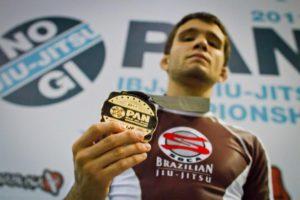
3 Phases to Complete Combat Sport Skill Development
by Daniel Faggella
Awhile back, I spoke at a seminar that required me to put boil down my Science of Skill presentation into about 20 minutes. And from that, I’ve put together this quick reference guide to the Science of Skill system, the same process I used at my MMA gym, so that everyone can maximize the effectiveness of their mat time to become a better grappler or fighter, fast!
Phase I Evaluating Where You Are
1) Varied Feedback Methods
The mistake most people make when figuring out how to “get good fast” in a combat sport is in their own evaluation. Ask a Brazilian Jiu Jitsu player how he determines his strengths and weaknesses, and he’ll likely explain that he recalls his past performances and notes what worked and what didn’t. Or he’ll make a note of what’s working and what’s not as he’s training, such as seeing the effectiveness of his backtakes or that he’s constantly getting tapped with kimura.
While self-reflection on the past and present are good tools for evaluating one’s game, there are several other tools available.
A complete list includes the following:
- Past Reflection – self reflection
- Present Reflection – self reflection
- Film Analysis – self analysis
- Past Reflection – outside expert’s perspective
- Present Reflection – outside expert’s perspective
- Film Analysis – outside expert’s perspective
In a perfect world, a self-evaluation would include as many of these methods as possible. An objective analysis of your game from someone else, especially an expert or instructor who’s familiar with you, is a huge key to improvement. An expert opinion, as well as film analysis, both offer insights that one just doesn’t get from self-reflection alone.

2) Strengths Mapping
With your game evaluated via as many of the above options as possible, the best way to build from all that analysis is to create a summary map of your overall skill sets and where they each fit. The method I use is to map your strengths, neutral areas and areas that need improvement in each of your technical, physical and mental games. Just make sure to use your own skills as your reference point. I’ve spoken at length on this topic in the art of Jiu Jitsu, but it’s a process you can follow along with in literally any sport.
Phase II Evaluating Where You Want To Be
This one’s easy since, in this pocket guide version of Science of Skill, we’re going to assume that everyone’s primary goal is to improve as fast as possible. And here’s how to do that:
3) Critical Improvement Area (CIA) Determination
With your strengths map ready, ask other high-level instructors and training partners this one simple question: “What areas of my game, if improved upon, would have the greatest overall impact on my quick development in this sport?”
Remember that, occasionally, this involves working on both strengths and weaknesses.
Further, don’t confuse “critical improvement areas” for “things I’m bad at and need to improve upon.” Quite often, you or your instructor may find a strength area is one that you should actually work on developing further.
Once you’ve determined where you need to improve, circle or highlight those areas on your strength map.
Phase III Getting From Here To There
4) Now that you know your critical improvement areas, the next goal is to work on the “highest yielding” areas of your game. And the best way to do that is to integrate measurable, weekly goals into your regular weekly schedule.
In the name of simplicity, break your goals into drilling goals and sparring goals (which are usually the most effective). A drilling goal is one where you “rep out” a technique or sequence a given number of times or minutes. Sparring goals are, obviously, situational sparring matches focused on the areas where you’re trying to improve.
This is a system that’s simple, easy to stick to, and it can turn weaknesses into strengths in as little as three months. Just remember to start small with two or three specific goals. As an example, with a goal of improving your passing game, incorporate these goals into your routine:
- 10 minutes of foot lock reps from within your opponents guard per week
- 40 stack press repetitions per week
- Two full length IBJJF matches per week
With a full, objective evaluation of your game and an educated, outside opinion of the areas where you need to place the most emphasis, this approach will be twice as effective in furthering your improvement.
 5) Re-Calibrate and Move Forward
5) Re-Calibrate and Move Forward
My recommendation is that you allot three months to each improvement project followed by another evaluation, another look at your CIAs, and then another three month emphasis on your new goals. And remember that you may even want to focus on the same goal for six or even nine months.
Now you’ve got it... my quick guide for super fast improvement in your combat sport. And that improvement is easy as long as you keep training hard and training smart!
- - -
Dan Faggella is a No-Gi Gold Medal Pan Am Champion at 130 pounds - renowned for his unique “Inverted” techniques in the Brazilian Jiu Jitsu world.




